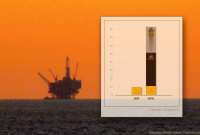Support strong Canadian climate journalism for 2025
Deep under the choppy waters off Newfoundland and Labrador’s coast lies the key to the province's financial future: billions of barrels of oil it hopes will be extracted over the coming years.
That's how Newfoundland and Labrador is framing its latest push into offshore drilling, anchored by the recent federal approval of Bay du Nord. That project, if built, will become Canada’s first deepwater oil site, emitting 30 million tonnes of carbon dioxide pollution annually. Now, Newfoundland and Labrador hopes to attract more projects like it, inviting the world’s oil majors to further explore the area off its coast and add more oil production to the economically struggling province’s balance sheet — all part of a plan to double offshore oil production by the end of the decade.
“From the perspective of the provincial government, Bay du Nord is the next step in what's going to be an even wider opening up of the offshore,” said Angela Carter, a University of Waterloo politics professor based in Newfoundland and author of Fossilized: Environmental Policy in Canada's Petro-Provinces. “This is about a commitment to expand the offshore to an unprecedented level.”
To understand the scope of this expansion, Canada’s National Observer has mapped all oil exploration, production and significant discovery licences as well as areas where companies have been invited to bid on projects this year. It also shows where exploration wells have been drilled in the past.
View the full-screen version of this interactive map by Esri Canada
The map is interactive, so you can click on an area to find information about who owns each licence, financial information, and more. Using the legend, you can click on the layers, toggling them on or off to help navigate the map. Active oil production and significant discoveries are labelled. All information included on the map was provided by the Canada Newfoundland and Labrador Offshore Petroleum Board (CNLOPB), a joint provincial-federal regulator that oversees the province’s offshore oil and gas industry.
Active production licences (in red) show sites that are currently extracting oil. In yellow are what’s called “significant discovery licences”: parcels where companies have found notable oil reserves but aren't extracting, at least yet. Exploration licences (in blue) are parcels companies have been awarded the right to explore and come with commitments to spend a certain amount by a certain date. The black dots show where wells have been drilled to look for oil. In purple are the parcels the regulator has open for bidding but that are not yet owned by any company. The red star shows where Bay du Nord is located (although it's worth mentioning, its owner, Equinor, owns several nearby parcels it collectively refers to as the Bay du Nord project).
The map reveals clusters of investment activity. Around producing oilfields like Hibernia and Hebron (shown in red on the map) are other significant discoveries in a region called the Jeanne d’Arc Basin on the Grand Banks of Newfoundland — an area historically important to the province’s fishing industry.
Bay du Nord (where the red star is) is farther to the northeast and represents a new play for oil in an area called the Flemish Pass. The map shows other significant discoveries in the Flemish Pass, called Mizzen, Harpoon and Baccalieu — all majority-owned by Equinor. Those other discoveries helped Equinor decide to proceed with the Bay du Nord project because the company can redesign its plans to tap those other wells, adding hundreds of millions of barrels to the project’s business case.
The regulator’s call for bids also shows plans to expand further into the Flemish Pass, as well as a whole new region to the island’s southeast. The province says its oil and gas reserves span an area larger than the Gulf of Mexico.
Andrew Parsons, the province's minister of industry, energy and technology, was not made available for an interview before publication, but in 2020, he said the plan to boost production was supported by the fact the offshore is rich with oil reserves. Existing oilfields have about two billion barrels of oil left, but it’s estimated billions more exist.
The first step for Newfoundland and Labrador is to increase exploration because without more sites to drill, more oil can’t be extracted. “Exploration drilling is of highest importance to unlocking hydrocarbon potential,” according to the province.
To do that, Newfoundland and Labrador launched its Offshore Exploration Initiative in 2020, a reimbursement program aimed at increasing the number of exploration wells drilled off the coast between 2021 and 2024. At the time, Parsons said it was important to “incentivize near-term drilling” or else the province’s competitiveness in the global market would be hit.
If Newfoundland and Labrador continues to develop its offshore oil industry, it will be significantly more challenging for Canada to reach its emission reduction targets, and further development will impose devastating consequences for marine ecosystems.
Newfoundland and Labrador has three organizations working to attract investment in its oil industry. They are the province’s Department of Industry, Energy and Technology, a Crown corporation called the Oil and Gas Corporation of Newfoundland and Labrador and the provincial-federal regulator, the CNLOPB.
Together, these organizations study the offshore to find oil deposits and provide data to fossil fuel companies to attract exploration investment. Each year, the regulator opens up an area for investment and invites companies to bid on parcels ripe for exploration. It announced in May that 28 parcels spanning more than seven million hectares are up for grabs in the eastern region of Newfoundland, while 10 parcels covering 2.6 million hectares are available in the southeast area off the province’s coast. Together, that’s an area nearly the size of New Brunswick. Bids are open until November and will be granted in early 2023, according to a press release from the board.
When the pandemic hit, major investments in offshore oil development were put on the backburner. Data shows that in 2019, three exploration licences were issued, compared to only one in 2020 and zero in 2021.







Comments
Here is another map to compare to the petroleum exploration leasing blocks indicated above.
https://www.nrel.gov/gis/assets/images/wtk-100-north-america-50-nm-01.j…
Newfoundland & Labrador and Quebec (N&L + Q) have the highest wind power potential in North and Central America. They have some of the largest hydropower projects on the planet completed or nearing completion, of course not without huge impacts on riparian ecological systems. There are undersea high voltage power cables in the works linking to Nova Scotia, New Brunswick and the Eastern Seaboard of the US that Quebec Hydro intends to use for export. Wind projects may well piggyback on them sometime in future.
Given the vast area where the wind can blow your hair off -- literally thousands of square kilometres -- it is feasible that N&L + Q could supply low emission, reasonably priced electricity generated from water and wind to the entire continent right down to the Panama Canal. Feasible, maybe, but not likely given the overlapping political, energy and private interest silos and the sheer number of turbines required.
This is just to demonstrate that renewables, dominated by cheap wind power, are always available with lower investment levels required to bring it to market. Offshore wind is feasible off the coast of BC, but not off the east coast where icebergs change the game. Therefore, onshore wind farms along the N&L coast and higher elevation inland sites can and should be a part of the plan.
As long as the world price of oil is driven up by artificial shortages created by, for example, Putin's stupidity and tragic comedy regarding the war on Ukraine, it will be feasible to finance and profit from Bay du Nord and other drilling projects in that region. Putin is incompetent at war and just as incompetent about managing Russia's fossil fuels and is shooting himself in the foot by threatening to cut Europe off from his oil and gas. 2023 could bring a new world order regarding diminishing the role fossil fuels play, thanks to Vlad who clearly suffers from little man syndrome.
A couple of months after the war started, the EU doubled down and has now nearly filled its gas storage tanks for the winter using increasing quantities of non-Russian LNG. It is mandating a minimum 15% reduction in gas use this winter, which will tide Germany, to cite one example, to March before the reserves run out. It will be a slog, as it faces steep inflation and a long winter with possibly some very significant cold snaps, but it will pull through free of Russian fossil fuels and dovetail with an energized EU initiated push toward renewables and greater interconnectivity in the continent's electricity grid.
Russian oil will also be subject to a price cap. This is a very smart, well thought out idea by the EU. It allows Russia to ship oil, but only to its smallest customers at a reduced price. China and India are now getting a discounted price, but they are also in line for sanctions if they continue. Russia may also act with stupidity on oil exports and cut the flow. If oil stops flowing, there are very serious technical ramifications for pipelines, refineries, wells and other infrastructure. They can flare off the gas, but they can't do anything with oil but let it sit there and corrode the metal and solidify.
Russia's pipeline capacity flowing west toward the EU is massive, but relatively tiny heading east and south toward China. Gas pipelines follow the same pattern, but Russia has no LNG capacity to allow it to export gas via specialized tankers.
The world shipping industry operates with insurance supplied by 13 re-insurers that are based in G7 nations. Britain alone has eight of their HQs. They will be subject to sanctions if they provide insurance services for oil tankers carrying Russian oil. Tankers without insurance will not be allowed to dock in the ports of advanced industrial nations. The implications of spills not covered by insurance may even ban them from the territorial waters of most nations.
The economic implications for Russia will be far worse than any other nation. A full-on recession may be in the works for the world over winter and into next year, but Russia could see it devolve further into a depression. The EU was dumb to allow itself to become so addicted to cheap Russian carbon, but Putin was a brainless economic pig for raking off probably a trillion US dollars worth of revenue to enrich 100 of his pals (some of whom are now being murdered for speaking out) and himself, and to place all his nation's eggs in one financial basket.
Too many ordinary Russians are willingly duped by Putin's expansionist propaganda and haven't a clue about what is coming down the pipe. Russia is on its way to being a failed state and will be ripe for another revolution. As a descendent of Ukrainians, and after seeing the images of the utter destruction of Mariupol and the murder of 87,000 of its innocent citizens, amongst other war crimes, I couldn't give a rat's ass.
The world will likely see stormy economic seas for a couple of years post Russian manipulation of the planet's oil dependency, but fossil fuels are heading for an insidious decline as liquid fuels in land transportation and gas for heating convert incrementally to electricity.
That means Bay du Nord, even without a build out of N&L + Q wind power, could become a stranded asset in a few years, just as it comes on stream. It's nearly impossible to imagine otherwise with all the world's major car makers having already invested hundreds of billions into electric vehicles, with wind and solar already competing with gas in power generation -- even before cheap, large-scale non-lithium power storage has been commercialized, and with the effort to fight back against war mongering little men like Putin armed with an 18th Century colonial mentality on the greedy exploitation and manipulation of resources and fellow nations while dreaming of empire.
It is worth pointing out that the new federal Impact Assessment Act (IAA) clipped the wings of the industry-captured National Energy Board while leaving the two offshore regulators the CNLOPB and CNSOLPB alone. They remain captured promoters, rather than regulators and the IAA is, in effect, non-operable in the Eastern offshore. This has happened as much by design as by default. Both the Commons and Senate committees responsible for reviewing the new IAA failed miserably to hear evidence of offshore cumulative effects on everything from climate change to the the fishery to marine species at risk. Meanwhile the Trudeau Liberals have been happy to oversee a completely inadequate regional impact assessment under the new IAA of the area comprising Bay du Nord and use that bogus assessment as a pretext to green light the unacceptable. The country is still asleep where protection of our precious Atlantic coastal waters are concerned and greedy corporations and their short-term political agents are happy to take advantage of us and damn the future!
There is an interesting development that will likely affect the profitability of Bay du Nord before it'd even completed, which by definition is an expensive form of oil exploration, and that's the latest drivers of the world price of oil.
Russia has threatened to slow or eliminate its oil and gas output to the EU, then randomly followed through on that threat to an extent, which placed world production in question. Econ 101: Limit the supply, see the price climb. Predictably, Putin immediately gloated at the higher levels of revenue, which helps finance his corruption and self-defeating war in Ukraine. OPEC, the world's leading cartel of petroleum producers, is also happy with the higher price.
But the EU and G7 are smarter. They created a BUYER'S cartel which will pay only up to a price cap per barrel of Russian oil they themselves determine. They also easily persuaded the world's massive shipping re-insurance industry to join on their side regarding Russian petroleum products. A buyer's cartel is a new thing, and it could evolve as a powerful tool not just to defeat petrostates run by tyrants, but to fight climate change under the right circumstances.
Bulk buyers in the EU have effectively reversed the tables on Russia. There are several reasons why the EU is now in an excellent position despite the impending cold season:
* Its winter storage reserves for gas are nearly full, thanks to Putin's threats which supplied enough impetus to focus on storage while strengthening the EU and uniting NATO.
* There are alternative external sources of oil and gas now coming on stream in the EU specifically to help Europe endure the next 6 to 12 months.
* Concurrently, the EU has set new, hardened policies in place to ramp up decarbonization and investments in renewables and to complete a continental electrical grid. Ditto a rail network. Oil and gas are now seen as a temporary crutch to get them over the immediate consumer demand for energy over winter and into next year when they can take breath and regroup. Recessions and cold weather be damned.
* The world's road transport sector is moving inexorably toward electricity, and that will provide even greater inertia to decarbonize the EU as the pandemic brakes on the world's supply chains come off and the production of microchips and non-cobalt lithium batteries is reshored (there are several plants under construction in the US and the EU) and collectively accelerate.
The buyer's cartel on Russian oil will have ramifications for the world oil price after it's initiated on Dec 5th. If this catches on while EVs and expansion of the world's electrical grids shifts into high gear, then expensive new oil and gas exploration projects will no doubt be mothballed as demand slips.
It is irksome how our public and corporate leaders are not paying any attention to the potential that economic dampers on their own may make convert these projects into stranded assets while tankers filled with fresh public subsidies sink. A buyer's cartel, if expanded even a bit beyond Russian petroleum, may become a surprisingly powerful new tool to fight climate change side-by-side with EVs and renewables that doesn't require any help from environmentalists. In effect, economics is doing the heavy lifting where regulations are purposely left weak because of control over policy by vested interests, and environmental organizations are asleep because the topic is saturated in an economic reality more powerful than decades of protest.
For more on this analysis check out Jeffrey Sonnenberg, an economist with Yale, here interviewed the other day by DW, an English language network based in Berlin.
https://www.youtube.com/watch?v=ooIdJfmqgK4
An analyst who studies world financial and energy markets also elucidates on Russia's self-inflicted predicament and Yale's groundbreaking recent report. His YouTube handle is 'Joe Blogs', and these are a few of the highly informative talks he recorded on this subject. Have a look at his other stuff too.
https://www.youtube.com/watch?v=t2p6X_upSXQ
https://www.youtube.com/watch?v=0Ws3YgumfoI
https://www.youtube.com/watch?v=h-fdRlC7OHE&t=1401s
DO we really need to read the long evaluations on the positive and negative side of oil proliferation at this point in time. How incredibly sad and disheartening. Our governments are leading us/our grandchildren to doomsday. CAN THIS BE HAPPENING WITH 21ST CENTURY ENVIRONMENTAL SCIENCE AND LIVING IN REAL TIME CLIMATE CRISIS ACROSS THE GLOBE. I am so tired of irresponsibility and greed.....like are we not intelligent enough to see beyond $$$$$$ value of our decisions .....GREED is a human desease and that is what we should be evaluating and coming up with solutions to find ways to invest in industries that could prevent poverty rather than stupidly OF RELYING ON OIL that is LITERALLY KILLING US. INTELLECTUAL Evolution of our species is stuck in an oil slick going backwards. MINDBOGGLING STUPIDITY..... GREED RULES....SO VERY SAD..... this will be our legacy to next generations